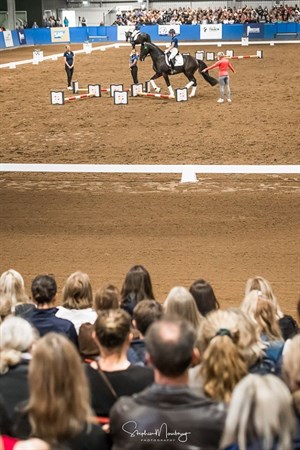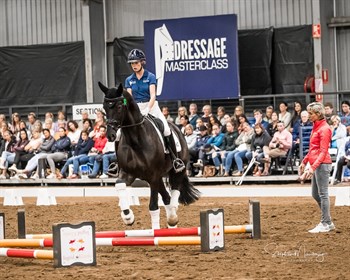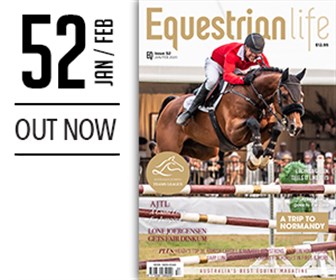
The crowd watches Dante Quando, ridden by Charlie Welsh.
© Stephen Mowbray / Dressage Masterclass
By Dr Kerry Mack
The second group at the Ingrid Klimke masterclass included the 6-year-old stallion Dante Quando, ridden by Charlie Welsh, and the mare Sugarloaf Fefe, ridden by Clarissa Bentley-Bell.
Dante enters the arena very alert and thinking his own thoughts. He isn’t thinking much about his young rider, Charlie. He dashes off in his own direction, possibly thinking about Fefe. Ingrid immediately offers help: “Turn him in a small circle.”
Basic control is regained and Ingrid points out that “with a stallion, it is especially important that he must know that you are the boss.” She gets Charlie to “do a small trot, a small circle and a small trot.” Speed control is regained then it is onto the trot, walk, trot exercise that we saw earlier.
“Don’t halt; if you can’t stop him then don’t ask.” This makes a lot of sense. Be happy to slow him down, ask him to give something that he is prepared to give. And then ask for more progressively. “Don’t lean so far back; sit more forwards so that you can swing your hips.”
6-year-old stallion Dante Quando, ridden by Charlie Welsh.
© Stephen Mowbray / Dressage Masterclass
Once again the cavaletti is part of the warm-up. First Charlie asks him to trot around them a few times, to show him. Then when he declines to go over them when asked, Ingrid instructs that he can stop, or go back, but Charlie is not to let him turn away from them. He tries to go to the outside (left) of the cavaletti, so Ingrid asks Charlie to steer to the right (inside) of the curved line of the three cavaletti in a fan shape. Once he agrees to do it, the turning every step really gets him to focus on the job. “Now he is paying attention,” Ingrid praises and adds the fourth rail. “Keep both eye and ears with you. More bending, more flexion. Good. Now do something else… transitions. Keep him busy.”
Clarissa and Fefe’s turn. This combination is clearly well prepared for the cavaletti work. Fefe understands the poles. Two sets of four cavaletti are set up in a fan shape to form a figure eight of about 12 metres centred at X. First rising, then sitting. This is a collecting exercise. Rhythm, suppleness, contact. Clarissa is asked to keep bending the mare. More bending every stride as she turns over the poles. When the exercise is done well after only a few repetitions, it is back to the lesson plan. Collected work always followed by lengthening, medium trot on the long side, sitting trot on the short side, and then open her up again. And a walk break.
Sugarloaf Fefe, ridden by Clarissa Bentley-Bell.
© Stephen Mowbray / Dressage Masterclass
The next cavaletti exercise is the same figure of eight, but one circle at trot and one at canter. The transition and the change of direction are at X. Before starting, Clarissa shows Fefe the exercise by cantering around the outside of the rails. Ingrid wants to set these things up so the horse succeeds. There are no tricks or unfair questions. Only step-by-step progressive training. This figure eight requires horse and rider be really focussed; a lot of bending, and being really supple. Once again well done, lengthen up the long side, walk, stretch.
Dante has a super canter and Ingrid’s compliments give his young rider confidence. Transitions within the canter are asked for. Sink into the saddle. This instruction is repeated many times in each lesson. “Half halt, sink into the saddle, give the aid with your seat first and your hand last.”
“Lengthen along the long side, and half way sink into the saddle, turning a small circle.” The exercise causes the horse to collect himself and find his balance. “Now he has collected, go medium.” Then, “ride the whole arena in counter canter, then a soft transition to trot and canter again.” Repetition helps Charlie get Dante more through.
There is the lesson plan again: Collected work, lengthen, walk on the buckle, finish with a stretchy circle.
The Medium horses are up next — stay tuned.
CATCH UP ON KERRY'S REPORT FROM THE FIRST SESSION HERE.
READ THE LATEST NEWS ARTICLES HERE
https://www.equestrianlife.com.au/articles/Ingrid-Klimke-Dressage-Masterclass-Managing-a-distracted-stallion



